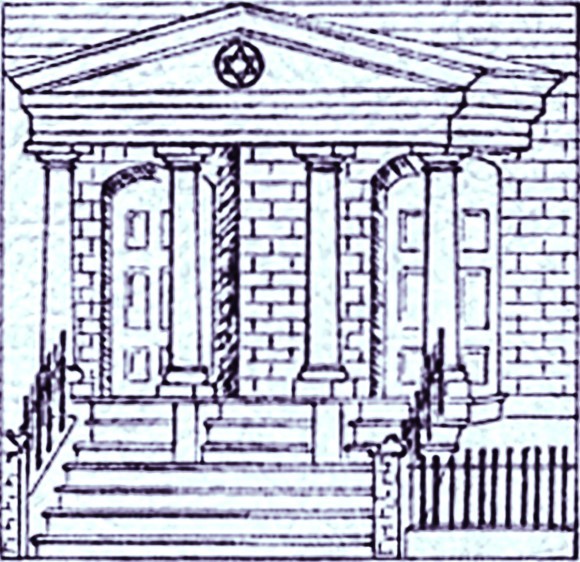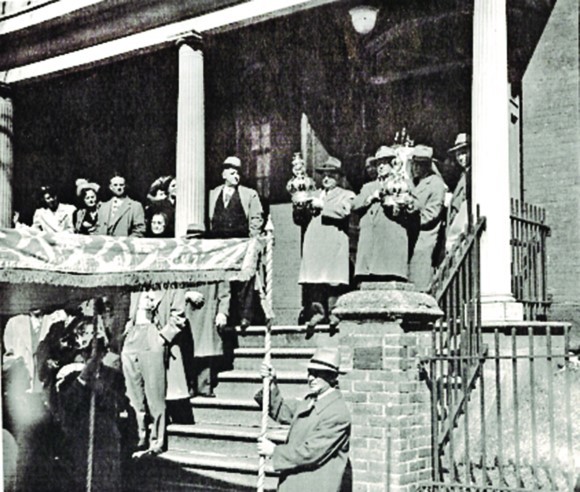The many lives of the Howell Street shul
Researchers, while searching our extensive collections for information about relatives or distant ancestors, often ask me supposedly “quick” questions as an aside. A common one is “What is the oldest ...?”
This is the complex story of the oldest synagogue building on the East Side of Providence.
As those who attended our annual meeting in April learned from Rachael Rosner’s wonderful discussion on early East Side history, the first synagogue on the East Side was Congregation Ahavath Sholom, on the corner of Howell and Scott streets, close to North Main Street. It began in 1905-1906, and many of the founding members later went on to found Providence’s Temple Emanu-El in 1924. The founders included the Rose, Siegal, Fain, Temkin and Alper families. At the time, the Jewish community on the East Side was clustered around Benefit Street and Lippitt Hill (where University Heights is today).
The Howell Street shul was located in the old wooden Fourth Baptist Church building, and it took six months to finalize the purchase and renovate the structure to meet the needs of the congregation. The founding members raised $2,000 to alter the building for Orthodox Jewish practice, and took out a $10,000 mortgage to buy the building. They wanted to create a synagogue, Hebrew school, and community center for the Jews who were increasingly moving to Lippitt Hill.
Even in 1940, Ahavath Sholom could claim in its anniversary book that its “beautiful Synagogue is among the largest in New England.”
While it was a traditional Orthodox synagogue, the earliest minute books, now in the RIJHA archive, are in English rather than Yiddish and some of the earliest rabbis were clean-shaven. While perhaps unsurprising today, these two facts were very unusual for Orthodox synagogues of this period. It reflected on the membership and the founders, who were largely young first-generation Americans, children of families firmly established in the Providence Jewish community as well as the larger business environment of Providence. These individuals wanted to move a little closer to the richer parts of Providence, but maintain and build Jewish institutions in their new neighborhood.
At first, the spiritual leadership was undertaken by Rabbi David Bachrach, a major leader of the Providence Jewish community since 1899. But the biggest change and excitement came in 1939, when the soft-spoken Rabbi Morris Silk became the rabbi of the Howell Street shul. Along with Rabbi Silk came his wife, Diana Silk, a forceful personality who was to become a community institution in her own right. With their arrival, energy and initiatives started in earnest at the Ahavath Sholom Synagogue and Hebrew Free School.
Rabbi Silk made the growth of the congregation a priority. From 1940 to 1949, the congregation undertook to build a new Ahavath Sholom on Rochambeau Avenue and Camp Street. When construction began in 1949, they only had enough money to build the first floor of the two-floor design. With the recent Holocaust and Jewish preservation at the front of their minds, they chose to build the Hebrew School first, rather than the main chapel. For many years, some in the community called it the “half a shul.”
With the death of Rabbi Silk in 1952, the main congregation on Rochambeau moved toward the Conservative movement with Rabbi Reuven Siegel. By the time the main sanctuary was built in the 1960s, the congregation was a Conservative synagogue called Temple Beth Sholom. It later went back to Orthodox practice, in the 1980s, but the top floor still retains the Conservative architectural feel.
But that’s not the end of the story of the Howell Street shul. At the time of the urban renewal of University Heights by individuals such as Irving Fain in 1960, a small group of Holocaust survivors were using the old shul building for services. They called the synagogue Mishkon Tfiloh, and they thought the idea that the city would take the old building, and pay good money for it, was “a miracle.”
After two years of holding services in the current Jewish Community Center, on Elmgrove Avenue in Providence, the congregants were able to cajole a homeowner on Summit Avenue into selling his house to them. The city gave permission to remove the beautiful ark from the Howell Street shul, which was installed in the main sanctuary of Mishkon Tfiloh’s new home.
While the name, families, and even the ark of the Howell Street shul remain an integral part of the East Side Jewish community today, the building itself was torn down as part of the University Heights urban renewal. It stood where the Whole Foods parking lot stands today.
JOSHUA JASPER is the new librarian/archivist for the Rhode Island Jewish Historical Association. Beginning June 1, the RIJHA’s office and library will have new hours. For more information, call 401-331-1360 or email info@rijha.org.











